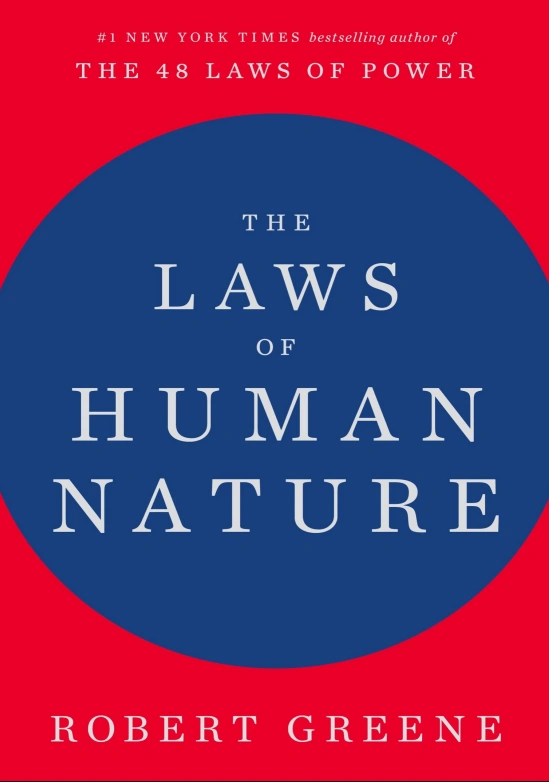
In The Laws of Human Nature , Robert Greene explores the deepest patterns of human behavior—from managing emotions to mastering influence. With rich historical examples and psychological insight, this book offers 20 timeless laws to help you understand yourself, navigate others, and transform adversity into power. A masterclass in self-awareness and social intelligence.
The Laws of Human Nature by Robert Greene is a deep dive into the psychological and behavioral patterns that shape human behavior. It’s his most comprehensive exploration yet of how people think, act, and react—especially in social and power-driven environments.
Building on the themes from his previous bestsellers like The 48 Laws of Power , The Art of Seduction , and Mastery , Greene shifts focus from strategy and manipulation to self-awareness and understanding others . This book isn’t just about controlling people—it’s about mastering yourself first , then navigating the world with greater clarity and influence.
Greene argues that human nature is not easily changed , but it can be understood. By recognizing universal tendencies—like our need for validation, fear of death, or desire for control—we can better manage our own impulses and anticipate the actions of others.
The book is divided into 20 laws , each exploring a fundamental truth about human psychology, supported by historical examples, philosophical insights, and modern case studies.
Let’s explore some of the key themes and laws:
Greene begins by emphasizing the importance of self-mastery . He believes that before you can understand others, you must first understand your own weaknesses, biases, and emotional triggers.
Emotional mastery is the foundation of rational thinking and strategic action. Greene warns against being ruled by anger, fear, or ego, which cloud judgment and lead to poor decisions.
Everyone presents a version of themselves to the world. Greene teaches readers how to read body language, inconsistencies in speech, and repeated behaviors to uncover true intentions.
This law encourages independence of thought and action. Greene urges readers to resist conformity and societal pressures that limit personal freedom and creativity.
Once we’ve mastered ourselves, Greene shifts focus to understanding the minds and motivations of others , helping readers become more persuasive, empathetic, and socially intelligent.
People respond to roles more than they admit. By crafting a strong persona—based on authenticity—you can influence how people perceive and interact with you.
Rather than forcing persuasion, Greene suggests activating people’s intrinsic desires . By aligning with what others truly want, you can guide them toward your goals without resistance.
A powerful psychological trick: let others believe an idea is their own. This increases buy-in and commitment, even if you planted the seed.
Not everyone is equal in influence. Greene advises identifying the real decision-makers—the ones behind the scenes—and focusing your efforts there.
These laws deal with broader group dynamics, organizational behavior, and how to operate effectively in complex social systems.
Your surroundings shape your mindset and behavior. Greene emphasizes the importance of choosing mentors, colleagues, and environments that elevate you.
Divide and conquer isn’t just a military tactic—it’s a psychological one. Weakening opposition by isolating its members makes victory easier.
Everyone has thresholds of endurance. Greene explains how to recognize these in yourself and others to avoid burnout or breakdowns.
This section focuses on resilience, growth through adversity, and turning life’s challenges into strength.
Avoid self-deception at all costs. Facing harsh truths—even painful ones—allows you to adapt and grow stronger.
Instead of suppressing negative emotions, channel them creatively. Many great works of art, music, and literature were born from pain.
Consistency beats intensity. Greene highlights how discipline, routine, and long-term vision are essential for sustained success.
The Laws of Human Nature is more than a self-help book—it’s a modern-day manual for navigating the complexities of human behavior . Greene blends history, philosophy, psychology, and storytelling into a compelling narrative that helps readers become more aware, influential, and emotionally intelligent.
He draws on figures like Socrates, Leonardo da Vinci, Abraham Lincoln, Coco Chanel, Carl Jung, and Martin Luther King Jr. , showing how they applied these laws in real life.
One of the most important takeaways is that people don’t change easily—but they can be understood . Once you grasp the recurring patterns in human behavior, you’re better equipped to manage relationships, lead teams, negotiate outcomes, and live with greater intention.
This book is especially valuable for: